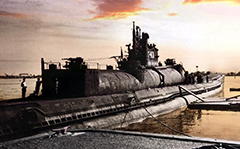The Sen Toku I-400-class Imperial Japanese Navy submarines were the largest submarines of World War II and remained the largest ever built until the construction of nuclear ballistic missile submarines in the 1960s.
They were submarine aircraft carriers able to carry three Aichi M6A Seiran aircraft underwater to their destinations. They were designed to surface, launch their planes, then quickly dive again before they were discovered. They also carried torpedoes for close-range combat. . They are considered the strategic predecessors to today’s ballistic submarines, especially to the Regulus missile program begun about a decade after World War II.
 The I-400-class was designed with the range to travel anywhere in the world and return. A fleet of 18 boats was planned in 1942, and work started on the first in January 1943 at the Kure, Hiroshima arsenal. Within a year the plan was scaled back to five, of which only three (I-400 at Kure, and I-401 and I-402 at Sasebo) were completed.
The I-400-class was designed with the range to travel anywhere in the world and return. A fleet of 18 boats was planned in 1942, and work started on the first in January 1943 at the Kure, Hiroshima arsenal. Within a year the plan was scaled back to five, of which only three (I-400 at Kure, and I-401 and I-402 at Sasebo) were completed.
The I-400 class was the brainchild of Admiral Isoroku Yamamoto, Commander-in-Chief of the Japanese Combined Fleet. Shortly after the attack on Pearl Harbor, he conceived the idea of taking the war to the United States mainland by making aerial attacks against cities along the U.S. western and eastern seaboards using submarine-launched naval aircraft. He commissioned Captain Kameto Kuroshima to make a feasibility study.
Yamamoto submitted the resulting proposal to Fleet Headquarters on 13 January 1942. It called for 18 large submarines capable of making three round-trips to the west coast of the United States without refueling or one round-trip to any point on the globe. They also had to be able to store and launch at least two attack aircraft armed with one torpedo or 800 kg (1,800 lb) bomb. By 17 March, general design plans for the submarines were finalized. Construction of I-400 commenced at Kure Dock Yards on 18 January 1943, and four more boats followed: I-401 (April 1943) and I-402 (Oct 1943) at Sasebo; I-403 (Sept 1943) at Kobe and I-404 (February 1944) at Kure. Only three were completed.
Following Yamamoto's death in April 1943, the number of aircraft-carrying submarines to be built was reduced from eighteen to nine, then five and finally three. Only I-400 and I-401 actually entered service; I-402 was completed on 24 July 1945, five weeks before the end of the war, but never made it to sea. More details
They were submarine aircraft carriers able to carry three Aichi M6A Seiran aircraft underwater to their destinations. They were designed to surface, launch their planes, then quickly dive again before they were discovered. They also carried torpedoes for close-range combat. . They are considered the strategic predecessors to today’s ballistic submarines, especially to the Regulus missile program begun about a decade after World War II.
 The I-400-class was designed with the range to travel anywhere in the world and return. A fleet of 18 boats was planned in 1942, and work started on the first in January 1943 at the Kure, Hiroshima arsenal. Within a year the plan was scaled back to five, of which only three (I-400 at Kure, and I-401 and I-402 at Sasebo) were completed.
The I-400-class was designed with the range to travel anywhere in the world and return. A fleet of 18 boats was planned in 1942, and work started on the first in January 1943 at the Kure, Hiroshima arsenal. Within a year the plan was scaled back to five, of which only three (I-400 at Kure, and I-401 and I-402 at Sasebo) were completed.The I-400 class was the brainchild of Admiral Isoroku Yamamoto, Commander-in-Chief of the Japanese Combined Fleet. Shortly after the attack on Pearl Harbor, he conceived the idea of taking the war to the United States mainland by making aerial attacks against cities along the U.S. western and eastern seaboards using submarine-launched naval aircraft. He commissioned Captain Kameto Kuroshima to make a feasibility study.
Yamamoto submitted the resulting proposal to Fleet Headquarters on 13 January 1942. It called for 18 large submarines capable of making three round-trips to the west coast of the United States without refueling or one round-trip to any point on the globe. They also had to be able to store and launch at least two attack aircraft armed with one torpedo or 800 kg (1,800 lb) bomb. By 17 March, general design plans for the submarines were finalized. Construction of I-400 commenced at Kure Dock Yards on 18 January 1943, and four more boats followed: I-401 (April 1943) and I-402 (Oct 1943) at Sasebo; I-403 (Sept 1943) at Kobe and I-404 (February 1944) at Kure. Only three were completed.
Following Yamamoto's death in April 1943, the number of aircraft-carrying submarines to be built was reduced from eighteen to nine, then five and finally three. Only I-400 and I-401 actually entered service; I-402 was completed on 24 July 1945, five weeks before the end of the war, but never made it to sea. More details